On our arrival we discovered we were not the only people out for a day at Matang. We met a large number of school students on an obvious field trip - something I so rarely see in a Sarawak nature park (Kuching parents are often reluctant to expose their children to the "risks" of the wilderness) that I wondered what was going on - even more so when I found the group was accompanied by my friend Oswald Braken Tisen of Sarawak Forestry.
Indeed, we had stumbled upon a special occasion - unfortunately almost concluded by the time we arrived: an Orangutan Drama Contest, arranged by Sarawak Forestry and the Wildlife Conservation Society and dedicated to "“rebuilding the cultural bridge between local communities and wild orangutans of Batang Ai and Lanjak-Entimau, Sarawak”. Students had been given a month to prepare competing dramas on the subject of orangutan conservation, and we had, alas, just missed seeing them staged. Nonetheless, I found it very heartening that such an event had taken place at all.
Most people come to Matang to see its rather dispiriting collection of caged wildlife. Matang is supposed to be a rehabilitation centre rather than a zoo of sorts, but it really does seem to be more of the latter than the former.
Mind you, it is (alas) almost the only way, today, for the average Sarawakan to see such creatures as the Sunda Clouded Leopard (Neofelis diardi), now regarded as a separate species from the Clouded Leopard (N. nebulosa) of the mainland.
The real pleasures of a trip to Matang are to be found in the wild areas along the trails. They include appreciating the beauties of its rich and varied a plant life, with the additional pleasure that some of the plants are labeled. This, for example, is Licualia petiolulata, a common endemic palm of Bornean forest undergrowth valued, among other things, as food and thatching material.
I have often thought that one should never enter a tropical forest without a good botanist to hand. Failing that, I have had the advantage (this time around) of my friends at Eileen's old stomping ground, the Sarawak Biodiversity Centre. My thanks to Asha Kaushal and Margarita Naming, then, and to an unnamed "lady in the traditional knowledge programme", for the names of some fascinating plants on the Matang trail.
This, for example - a flowering vine I have seen, photographed and scratched my head over before - is a species of Whitfordiodendron (a particularly wonderful name, so it is unfortunate that this genus is often included in Callerya these days). It is a relative of Wisteria, a plant I have growing in my Ontario garden, and if you squint a bit (and ignore the colour) its enormous inflorescence does look something like a mass of wisteria flowers on steroids.
This one I can recognize myself: a ginger, probably a member of the genus Etlingera, with its flower spike springing directly from the soil.
The fruits of tropical forest plants are often far more arresting than their flowers. The bright blue berries of this understorey plant, a member of the Rubiaceae (probably a species of either Psychotria or Gaertnera), considerably outshine the little white blossoms that precede them. Psychotria, so-called wild coffee (true coffee, Coffeia, also belongs to the Rubiaceae), is a large genus whose species are, notably, stuffed with alkaloids (as the generic name might suggest).
These fruits belong to a species of Piper, one of Sarawak's most iconic genera (it includes the pepper for which the state is famous).
Finally, these are the fruits of two undergrowth palms, probably both in the genus Areca.
Outside of Matang's cages and enclosures, most of the animals you can see on the trails are little ones. Mind you, this female Golden Orb Weaver Spider (Nephila pilipes) sitting at the centre of her elegantly-spun web is an impressive creature as smaller animals go.
Butterflies are fragile creatures. This Great Marquis (Bassaronya dunya), perched on the leaf of a Melastoma, is s much more ragged specimen than the one from Kubah that I featured in my last post.
My readers will not be surprised that I was particularly interested in hunting out odonates. The Matang Centre, with its combination of forest and edge and the number of streams that surround it, is a good place to seek them out. I found this mating pair of Neurothemis ramburii in an open area just outside the Centre entrance.
Orthetrum testaceum is a common open-country dragonfly, and again this one was outside the Centre itself.
The lovely Orthetrum pruinosum, however, is more of a forest edge dragonfly, and I found these males around the animal enclosures within the Centre gates.
In a damp patch near the river's edge I found a male Nannophya pygmaea, tiniest of Borneo's dragonflies, guarding its territory.
Deeper into the centre, in the forested shadows, damselflies seem to take over from dragonflies. Some were species I had seen frequently before, including Copera vittata (its bright yellow legs are striking for a reason: the male uses them in display) [ignore the incorrect name on the file!].
The brilliant iridescence of Euphaea impar always makes me stop for a look...
... as do the metallic greens of Vestalis damselflies. As usual I cannot tell which species this is, as I don't try to net them to examine their genitalia. V. amarylllis, possibly?
Prodasineura verticalis is colourful too, but it is so small that it is easy to overlook.
Along with these old favourites I found a couple of damselflies that I had not seen before. This one I could only photograph from a distance - it was inside the crocodile enclosure! It appears to be Prodasineura haematosoma, a species endemic to western Borneo, rather than the otherwise-similar P. hyperythra, because its seventh abdominal segment (the last long one before the short segments 8-10) is black rather than red (according to the description in A.G. Orr's A Guide to the Dragonflies of Borneo).
According to Orr, Pseudagrion perfuscatum is the only one of its genus in Borneo marked with orange-brown rather than blue. Assuming I have the genus right, then, that is what this mating pair, which we found above the drainage ditch by the animal enclosures, must be.
Matang is, it seems, one of the most reliable places (at least near Kuching) to find the otherwise rather uncommon Grey-bellied Bulbul (Pycnonotus cyaniventris), one of the handsomer members of its often-drab family. They seem particularly attracted to small fruiting trees planted along the entrance roads - I had seen it here before, and it was nice to find it again. The IUCN Red List notes that "Although this species remains widespread and common in many areas, it is suspected to be declining moderately rapidly in line with rates of forest destruction and degradation. It is therefore considered Near Threatened, and should be carefully monitored."
Many skinks can be difficult to identify, but (you would think) not this one. It is, I am quite sure, a Rough-backed (or Red-throated) Ground Skink (Eutropis (or Mabuya) rugifera), and the trouble is that it doesn't always look like this (and this could just possibly be its cousin the Black-banded Ground Skink (E. rudis), which again doesn't look like this much of the time). This is a male in full breeding colour, orange-red throat and all, and it is surely one of the most colourful lizards in Borneo. At other times, though, it is much lighter and plainer, with rows of light stripes along its back. Colour, I'm afraid, is not always the best guide to identifying lizards - a difficult concept for birders like me to accept!
The paths at Marang cross shallow streams where you can often get surprisingly good looks at the local freshwater fishes. This appears to be a local specialty, the False Spanner Barb (Barbodes kuchingensis). As its name suggests, it is a localized endemic confined to western Sarawak (the Kuching area) and neighbouring Kalimantan, Indonesia.
The Pitcher Plant Trail is an interesting side loop leading from the main trail around the Centre. I had never tried it before, so (with Ryan somewhat reluctantly in tow) we set off to explore it. Sure enough, if you follow it you do come to a patch of pitcher plants (Nepenthes spp). In this picture, though you can only see one pitcher (at the lower right), the long, flat leaves are enough to spot the plant in the centre as a Nepenthes. Notice that the pitcher is actually an extension of a long tendril growing from the leaf tip - an arrangement completely different from that found in the unrelated pitcher plants (Sarraceniaceae) of the Americas or the isolated (and equally unrelated) Cephalotus of southwestern Australia, in which the whole leaf forms the pitcher.
Here are a few close ups of the pitcher itself. Nepenthes rafflesiana is a "typical" pitcher plant, if such a word can even be applied to such a peculiar (and highly variable) organism. Its pitchers are insect traps, their prey drawn by the liquid inside, protected from being diluted on rainy days by their conveniently-placed lids (in Sarawak, locals use the pitcher as a cooking pot for rice or tapioca).
Just across the trail from our little patch of rafflesiana grew a quite different species, Nepenthes ampullaria. This species uses its pitchers not as insect traps but as rubbish pits, deriving nutrition from debris that falls from above into its open, unshaded pitchers (the lid in this species is very small, and deflected to one side so as not to get in the way).
The nutrient-filled liquid in the pitchers makes them, not death traps, but tiny ecosystems (technically referred to as phytotelms), home to insect larvae and other creatures, some of which can be found nowhere else. Any pitcher plant may have something living in its pitchers, but apparently ampullaria sets the Borneo record for the greatest variety of pitcher inhabitants, with 59 recorded species (though it is outdone by the North American Sarracenia purpurea, with 165 species - perhaps because Sarracenia's pitchers last longer). Far from being food for the plant, some of the creatures living in the pitcher may actually help to break down the leaf litter that falls inside and transfer its nutrients to their host.
Their most famous inhabitants (and the subject of an earlier entry in this blog) are the tadpoles of the recently-discovered Matang Narrow-mouthed Frog (Microhyla borneensis, originally known as M. nepenthicola), one of the smallest frogs in the world. The tadpoles do not even need to feed as they grow and metamorphose; they simply absorb what they need from their yolk sacs. For Ryan, I think these little guys made the extra walk worthwhile!



























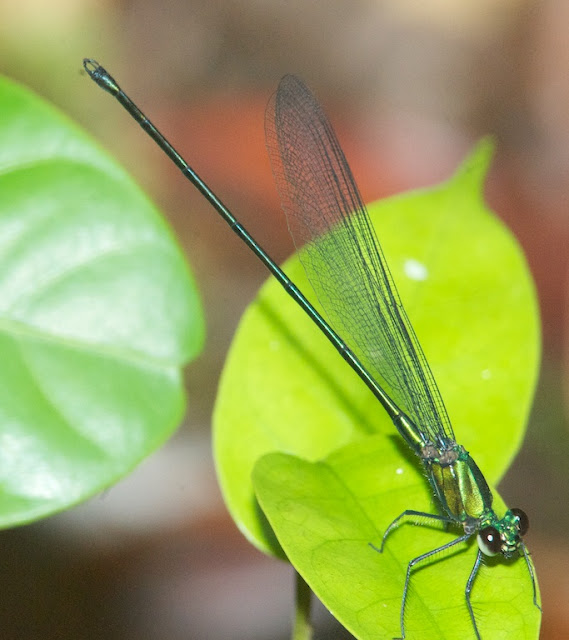

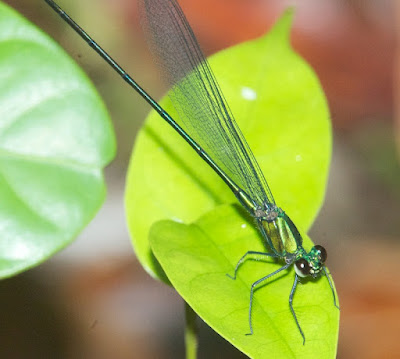



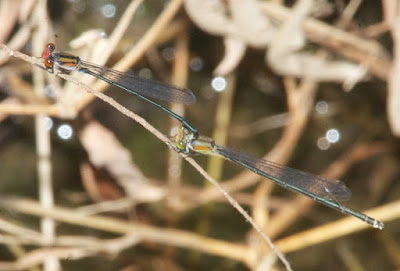
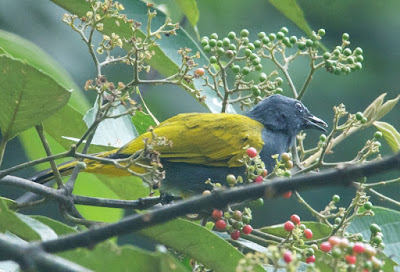











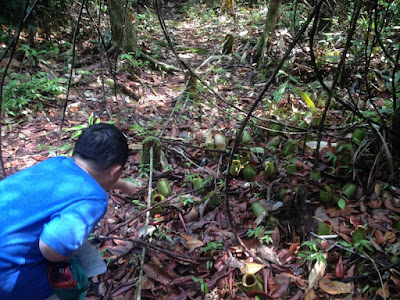





You have a very interesting blog here, Ronald. But I'll have to come back here many times to read all your posts, 😀
ReplyDelete